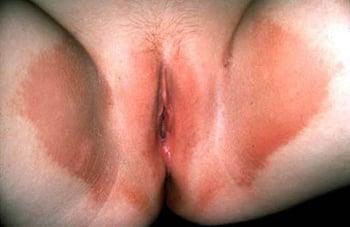Erythrasma is infection of the top layers of the skin caused by the bacterium Corynebacterium minutissimum.
Topic Resources
(See also Overview of Bacterial Skin Infections.)
Erythrasma affects mostly adults, especially those with diabetes and those living in hot and humid climates.
Erythrasma is most common in the foot, where it causes scaling, cracking, and breakdown of the skin between the last two toes. This infection is also common in the groin, where it causes irregularly shaped pink or brown patches and fine scaling especially where the thighs touch the scrotum (in men). The armpits, skinfolds under the breasts or on the abdomen, and the area just in front of the anus (perineum) are prone to this infection, particularly among people with diabetes and among middle-aged women with obesity.
In some people, the infection spreads to the torso and anal area.
Diagnosis of Erythrasma
A doctor's evaluation
Although erythrasma may be confused with a fungal infection, doctors can easily diagnose erythrasma because skin infected with Corynebacterium glows coral-red under an ultraviolet light.
Treatment of Erythrasma
Antibiotics taken by mouth or applied to the skin
An antibiotic given by mouth, such as clarithromycin, can eliminate the infection.An antibiotic given by mouth, such as clarithromycin, can eliminate the infection.
Medications applied directly to the affected area (topically), such as erythromycin, clindamycin, mupirocin, or benzoyl peroxide, are also effective. Medications applied directly to the affected area (topically), such as erythromycin, clindamycin, mupirocin, or benzoyl peroxide, are also effective.
Antifungal creams such as miconazole may be helpful if yeast or fungus is present in the affected areas as well.Antifungal creams such as miconazole may be helpful if yeast or fungus is present in the affected areas as well.
Erythrasma may return, necessitating a second round of treatment.


